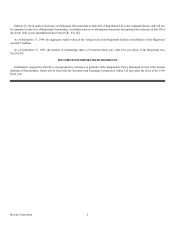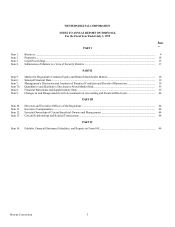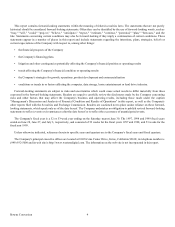Western Digital 1999 Annual Report Download - page 17
Download and view the complete annual report
Please find page 17 of the 1999 Western Digital annual report below. You can navigate through the pages in the report by either clicking on the pages listed below, or by using the keyword search tool below to find specific information within the annual report.Bowne Conversion 12
For an additional discussion of competition, see Part II, Item 7, under the heading "Risk factors related to the hard drive industry in
which we operate."
Service and Warranty
Western Digital generally warrants its newly manufactured hard drives against defects in materials and workmanship for a period of
one to five years from the date of sale, based on customer needs. The Company's warranty obligation is generally limited to repair or
replacement of the hard drive. The Company recently contracted with a third party in the United States to process and test returned
hard drives for the Company's end users. The Company refurbishes or repairs its products at in-house service facilities located in
Singapore and at a third-party return facility located in Germany.
Manufacturing
To be competitive, Western Digital must manufacture high quality hard drives with industry leading time-to-volume production at
competitive unit cost. The Company strives to maintain manufacturing flexibility, rapidly achieve high manufacturing yields and acquire
high-quality components in required volumes at competitive prices. The critical elements of Western Digital's hard drive production are
high volume, low cost assembly and testing, and establishment and maintenance of key vendor relationships in order to create "virtual
vertical integration." By establishing partner relationships with its strategic component suppliers, the Company believes it is able to
access "best-of-class" manufacturing quality without the substantial capital investment associated with actual vertical integration. In
addition, the Company believes that its virtual vertical integration model enables it to have the business flexibility needed to select the
highest quality low cost suppliers as product designs and technologies evolve.
Hard drive manufacturing is a complex process involving the assembly of precision components with narrow tolerances and
extensive testing to ensure reliability. The assembly process occurs in a "clean room" environment which demands skill in process
engineering and efficient utilization of the "clean room" layout in order to reduce the high operating costs of this manufacturing
environment. The Company's clean room manufacturing process consists of modular production units, each of which contains a
number of work cells. With the completed transition to magnetoresistive head technology for desktop PC hard drives, the Company has
recently increased its factory yields on desktop PC hard drives to its historically high levels.
The Company produces hard drives in its two plants, one in Singapore and one in Malaysia. The Company recently announced its
intention to move substantially all of its production of desktop hard drives to Malaysia, while retaining in Singapore production of
enterprise drives and expanding its role in design, development and manufacturing process engineering. As a continuation of its virtual
vertical integration model, the Company sold its media manufacturing division in 1999 to Komag, Inc. ("Komag"). With the sale of this
division, the Company now purchases all of the standard mechanical components and micro controllers for its hard drives from external
suppliers.
The Company continually evaluates its manufacturing processes in an effort to increase productivity and decrease manufacturing
costs. In order to address inventory oversupply, the Company has implemented production cutbacks in its manufacturing facilities and
has reduced excess manufacturing capacity through closure of one of its manufacturing facilities in Singapore and the announced
relocation of the remaining Singapore desktop hard drive production to Malaysia. The Company believes that more automated
manufacturing processes may be required in the future in order to be competitive in the hard drive industry and continually evaluates
which steps in the manufacturing process would benefit from automation and how automated manufacturing processes support the
Company's business plans.
For an additional discussion of manufacturing, see Part II, Item 7, under the heading "Risk factors relating to Western Digital
particularly."
Research and Development
The Company devotes substantial resources to development of new products and improvement of existing products. The Company
focuses its engineering efforts on coordinating its product design and manufacturing processes in order to bring its products to market
in a cost-effective and timely manner. Research and development expenses totaled $150.2, $203.7 and $217.0 million in 1997, 1998 and
1999, respectively. Research and development expenditures included approximately $22.0 million, primarily related to the initiation of the
























